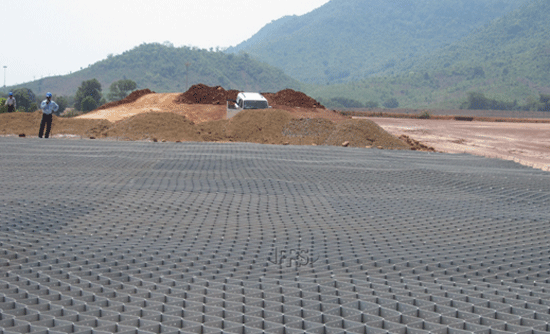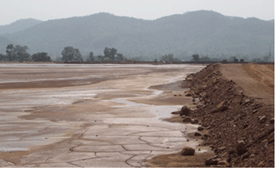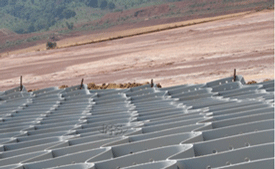

The Vedanta Aluminum company needed to increase the storage capacity of alkaline red mud (a waste/by-product of alumina processing) in open air ponds/ dykes constructed from unconsolidated red mud slurry.The goal was to strengthen the foundation of the 15,000 sq m embankment to support a 3m high addition to the earthen dyke.
The senior design engineering consultant, Dr. T.G. Sitharam (Chairman, Centre for infrastructure and Sustainable Transportation & Urban Planning – CiSTUP), Indian Institute of Science (IISc), Bangalore, chose the Neoloy solution after experimental and analytical modeling.
Lateral confinement by Neoloy Geocells transfers vertical loads horizontally, while the reinforcing mechanism creates a stiff geocell mattress. This stabilizes the footing of the embankment, reduces settlement and prevents slope failure. The proven durability of the Neoloy® polymeric alloy used to withstand large stresses in a harsh chemical environment over time gave a high degree of confidence to the solution.
CONVENTIONAL SOLUTIONS
Alternative solutions called for sand/stone columns and pre-vertical drains along the depth and base width of the dyke. These techniques are too difficult in the presence of water, required the import of sophisticated earth machinery to a very remote site, and would be a very complex and expensive solution.
PRS-NEOLOY SOLUTION
Neoloy-356 geocells 10 cm height were placed below the footing with a thin layer of sand layer to reduce settlement. A planar geogrid was installed at the base of the geocell mattress, which acts as a membrane, to improve the bearing capacity (after water was drained out). Free draining material at the base avoids direct contact with the foundation and accelerates consolidation of the underlying soft clay. Good quality murrum soil (granular sand, gravel) was used for infill, compacted to the required density.
Neoloy Geocell reinforcement contains and confines the shearing soil mass just below the foundation of the proposed dyke (footing). This transmits the footing pressure laterally and gives rise to higher load carrying capacity. Slope stability was confirmed by analysis.

